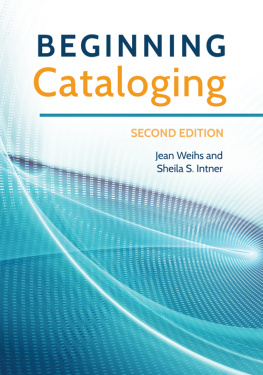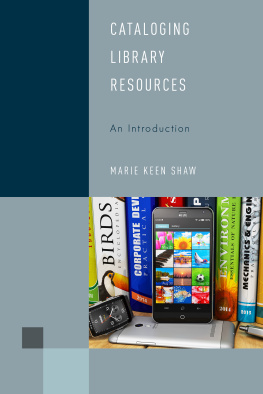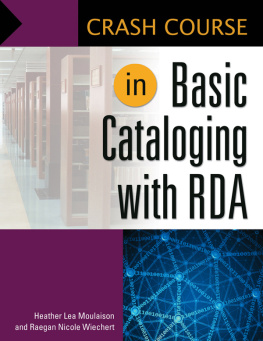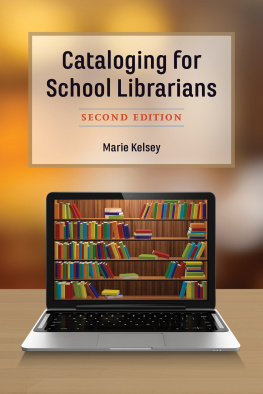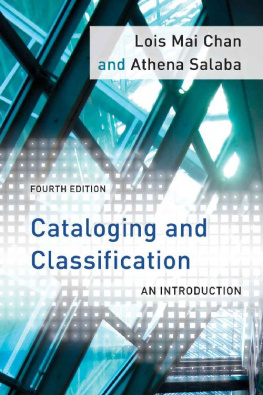Beginning Cataloging
Beginning Cataloging
Second Edition
JEAN WEIHS
and
SHEILA S. INTNER

Copyright 2017 by Jean Weihs and Sheila S. Intner
All rights reserved. No part of this publication may be reproduced, stored in a retrieval system, or transmitted, in any form or by any means, electronic, mechanical, photocopying, recording, or otherwise, except for the inclusion of brief quotations in a review, without prior permission in writing from the publisher.
Library of Congress Cataloging-in-Publication Data
Names: Weihs, Jean, author. | Intner, Sheila S., author.
Title: Beginning cataloging / Jean Weihs and Sheila S. Intner.
Description: Second edition. | Santa Barbara, California : Libraries Unlimited, an imprint of ABC-CLIO, LLC, [2017] | Includes bibliographical references and index.
Identifiers: LCCN 2016030108 (print) | LCCN 2016047912 (ebook) | ISBN 9781440838446 (paperback) | ISBN 9781440838453 (ebook)
Subjects: LCSH: Cataloging. | Classification--Books.
Classification: LCC Z693 .W45 2017 (print) | LCC Z693 (ebook) | DDC 025.3dc23
LC record available at https://lccn.loc.gov/2016030108
ISBN: 978-1-4408-3844-6
EISBN: 978-1-4408-3845-3
21 20 19 18 17 1 2 3 4 5
This book is also available as an eBook.
Libraries Unlimited
An Imprint of ABC-CLIO, LLC
ABC-CLIO, LLC
130 Cremona Drive, P.O. Box 1911
Santa Barbara, California 93116-1911
www.abc-clio.com
This book is printed on acid-free paper 
Manufactured in the United States of America
Contents
CHAPTER
Introduction
This book has been written to convey knowledge about standard methods of cataloging and classifying library materials. It is intended as a beginners introduction and does not attempt to be exhaustive.
As this books title states, it has been written for beginning catalogers, those who are students in library technician programs and teacher-librarian programs, and for other people who do not have formal training in cataloging but find themselves in situations in which cataloging must be undertaken. The text can also be effectively used as a workbook for students in cataloging courses at faculties of library and/or information studies. It may also help people in reference departments or students studying reference skills to have an understanding of the catalog.
Publication of this second edition is necessary because the basic rules of descriptive cataloging have changed from rules based on the Anglo-American Cataloguing Rules to RDA: Resource Description & Access..
Standardized Cataloging
The public catalog is the most important tool patrons can use to find what the library has in both its local collection and its remote access collection. Public catalogs can enable searchers to see what materials are available by particular authors or on subjects of interest, as well as what versions and editions of a title can be found in the collections.
Standardized cataloging is the key that opens the door of better access to local materialsmaterials that can satisfy patrons informational, recreational, and educational needs. Standardized cataloging not only enables local catalogs to perform better for their users, but also makes it possible for the local catalog to link more effectively with the other catalogs belonging to the same bibliographic network. These links might be to catalogs in public libraries, media centers, colleges and universities, special libraries, state and provincial libraries, or national libraries. Standardized cataloging also makes it possible to understand the bibliographic records in foreign-language libraries. The ultimate goal is to make any title owned anywhere in the world available to a person with a need for that material.
Good cataloging also contributes to the use of materials by making it easier for people searching the catalog to find what they want and need. A catalog containing high-quality, standardized information provides better responses to searchers queries. Standard methods can be applied to all kinds of information resources in all kinds of physical forms. Searchers are prepared for encounters with catalogs and collections in college, university, and corporate libraries when they have used a good-quality catalog in their local public libraries and school media centers.
With few exceptions, all libraries use standard tools to catalog their collections. These tools allow a library to use sources of catalog copy from other databases or from Cataloging-In-Publication (CIP) for a local catalogan effective way of reducing the costs of cataloging.
Functions of the Catalog
Charles Ammi Cutter, one of Americas most distinguished and innovative librarians, who published Americas first book of rules for cataloging materials in 1876, established the purpose of catalogs as follows:
To enable a person to find a book when one of the following is known:
a) the author
b) the title
c) the subject.
To show what the library has
d) by a given author
e) on a given subject
f) in a given kind of literature.
To assist in the choice of a book
g) as to the edition (bibliographically)
h) as to its character (literary or topical).
Cutter called these purposes the objects of the catalog. They have been valid for over 140 years and continue to express what current catalogs try to achieve.
Cutters objects describe two distinct functions for the catalog: a finding list function and a collocation (gathering) function. Patrons who approach the catalog with a known item in mind are served by the finding list function. When they search for the item, the presence or absence of a record for it in the catalog informs them if it is part of the collection. If patrons are not sure of an exact item, but want to select an item from among the works of an author, or find a particular edition of a work, or locate materials on a subject, the collocation function gathers all the records that match a chosen search term and helps to answer their queries. All the publications of an author are filed in one place under the heading for the authors name, all the editions of a work are filed together under the heading for the title, and all the publications on a subject are gathered under the headings for that subject. Searchers can scan the set of records gathered under their search terms (name, title, or subject) and select what they want.
Further Learning
People who have mastered the contents of this book, which deals with the cataloging of books, and want more in-depth knowledge of both book and nonbook cataloging, can move on to Standard is also a useful guide.
Blank pages with the heading Additional Information are available at the end of each chapter for a beginning cataloger to add to the knowledge in this book as she or he becomes more proficient in cataloging and has learned to consult some of the sources listed at the end of subsequent chapters. Such personal notes may be made when a cataloger regularly encounters a more complex type of material than is discussed in this book.
A Word about Figures and Exercises
The figures in to enable readers to apply the tools discussed within the chapters.
The figures in goes further to explain how the parts of a computerized record are represented in standard MARC (MAchine Readable Cataloging), and the figures and exercises in the chapters that follow use only the MARC codes. The figures and exercises in this book omit the MARC coding for those parts of computerized catalog records known as
Next page
